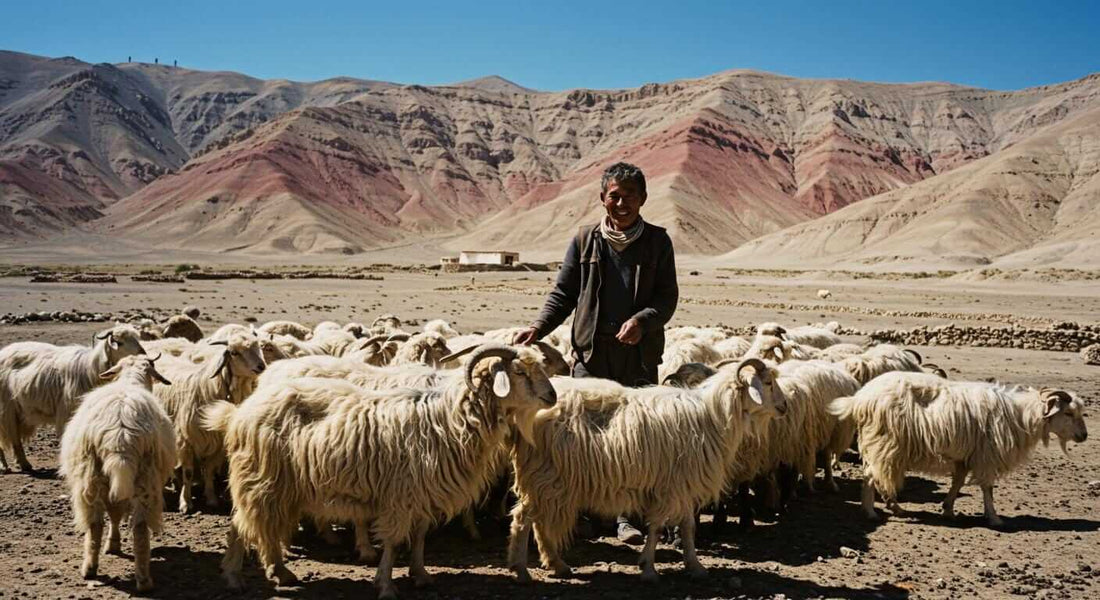
The Ultimate Guide to Authentic Himalayan Pashmina: Why Upper Mustang's Changra Goats Produce the World's Finest Cashmere
Share
Introduction: The Secret Behind the World's Most Luxurious Fiber
High in the remote valleys of Upper Mustang, Nepal, at elevations exceeding 14,000 feet, lives a remarkable animal that produces what many consider the world's finest natural fiber. The Changra goat (also known as Chyangra) has adapted to survive in one of Earth's harshest environments, and in doing so, has developed an extraordinary gift: the ability to grow the softest, warmest, and most luxurious cashmere known to humanity.
If you've ever wondered what makes authentic Himalayan pashmina so special—or why genuine pieces command premium prices while synthetic alternatives flood the market—this comprehensive guide will reveal everything you need to know about this remarkable textile treasure.
What Makes Himalayan Pashmina Truly Special?
The Science Behind Superior Softness
Authentic Himalayan pashmina fiber measures just 14-19 microns in diameter—significantly finer than regular wool (25-40 microns) and even finer than most cashmere varieties. To put this in perspective, human hair measures approximately 75 microns. This microscopic fineness is what creates pashmina's signature cloud-like softness and incredible warmth-to-weight ratio.
Key Properties of Authentic Pashmina:
- 3x warmer than regular wool despite being incredibly lightweight
- Natural temperature regulation - keeps you warm in cold weather, cool when it's warm
- Hypoallergenic properties - gentle on sensitive skin
- Moisture-wicking capabilities - naturally manages humidity
- Durability - with proper care, can last decades
The Upper Mustang Advantage: Geography Creates Perfection
The Upper Mustang region of Nepal, bordering Tibet, presents one of the most challenging environments on Earth. Here's why this harsh landscape is crucial for producing the world's finest pashmina:
- Extreme Altitude: At 14,000+ feet, oxygen levels are 40% lower than at sea level
- Temperature Extremes: Daily temperature swings from -40°F to 80°F
- Arid Climate: Less than 10 inches of annual rainfall
- Intense UV Radiation: Thin atmosphere provides little protection
These extreme conditions force Changra goats to develop an incredibly fine, dense undercoat for survival. This evolutionary adaptation is what creates the exceptional quality that makes Himalayan pashmina incomparable to cashmere from other regions.
The Journey from Goat to Gorgeous: Traditional Craftsmanship Meets Modern Ethics
Sustainable Harvesting: Respecting Nature and Animals
Contrary to popular misconceptions, authentic pashmina harvesting is completely humane and sustainable. Here's how it actually works:
This limited yield is one reason why authentic pashmina is precious—it takes the annual fiber production of 3-4 goats to create a single shawl.
The 7-Day Transformation: From Raw Fiber to Masterpiece
The creation of authentic Himalayan pashmina follows a meticulous process unchanged for centuries:
Hand-sorting fibers by quality and color, removing guard hairs and impurities, traditional washing in mountain stream water
Converting cleaned fiber into yarn using traditional wheels, maintaining consistent thickness and quality
Using centuries-old wooden looms, hand-weaving each piece individually
Final inspection for quality standards, gentle pressing and shaping
How to Identify Authentic Himalayan Pashmina: Your Complete Buying Guide
The NPIA Certification: Your Guarantee of Authenticity
The Nepal Pashmina Industry Association (NPIA) provides official certification for authentic pashmina products. Look for these indicators:
- Official NPIA Certificate: Accompanies every genuine product
- Certification Number: Unique identifier for tracking
- Fiber Composition: Confirms 100% pure pashmina (no silk, viscose, or synthetic blends)
- Origin Verification: Confirms Himalayan Changra goat source
The Touch Test: What Authentic Pashmina Feels Like
Genuine Himalayan pashmina has distinctive tactile qualities:
- Softness: Should feel like touching a cloud - incredibly soft without any roughness
- Weight: Surprisingly lightweight despite its warmth
- Texture: Smooth and even, without lumps or thick spots
- Elasticity: Gentle stretch and recovery without losing shape
Caring for Your Investment: Maintaining Pashmina's Beauty
Proper Care Techniques
Your authentic Himalayan pashmina can last for decades with proper care:
Cleaning:
- Hand wash in cold water with mild shampoo or baby detergent
- Never use harsh detergents or bleach
- Rinse thoroughly to remove all soap residue
Drying:
- Lay flat on a clean towel
- Never wring or twist when wet
- Keep away from direct sunlight and heat sources
Styling Your Authentic Himalayan Pashmina
Versatile Elegance for Every Occasion
The beauty of authentic pashmina lies in its versatility. Here are styling suggestions for different occasions:
- Professional Settings: Drape over shoulders as an elegant wrap, loop loosely around neck for sophisticated accent
- Evening Events: Wear as elegant stole with formal wear, wrap around arms for photo-ready sophistication
- Casual Wear: Light scarf for spring and summer evenings, cozy wrap for reading or relaxing
Color Selection Guide
Authentic Himalayan pashmina comes in various natural and dyed colors:
- Natural Colors: White/Cream (classic elegance), Light Brown (warm sophistication), Gray (modern neutrality)
- Traditional Dyed Colors: Deep Blues (reflecting the Himalayan sky), Rich Reds (symbolizing prosperity), Earth Tones (connecting to the mountain landscape)
Investment Value: Why Authentic Pashmina is Worth the Price
While authentic Himalayan pashmina requires a significant initial investment, consider the long-term value:
- Durability: With proper care, lasts 20+ years
- Timeless Style: Never goes out of fashion
- Versatility: Suitable for multiple occasions and seasons
- Heritage Value: Can become family heirloom
Conclusion: Your Journey into Authentic Luxury
Authentic Himalayan pashmina represents far more than a fashion accessory—it's a connection to ancient traditions, a testament to exceptional craftsmanship, and a sustainable luxury that enriches both your wardrobe and the lives of traditional artisans in some of the world's most remote communities.
When you choose genuine Himalayan pashmina, you're not just purchasing clothing; you're investing in unparalleled quality and comfort, timeless style that transcends trends, sustainable and ethical production, cultural preservation and community support, and a treasured piece that can last for generations.
Ready to experience authentic Himalayan luxury?
Discover Our NPIA-Certified CollectionDiscover our collection of NPIA-certified pashmina pieces, each handcrafted by master artisans in the remote valleys of Upper Mustang, Nepal.
